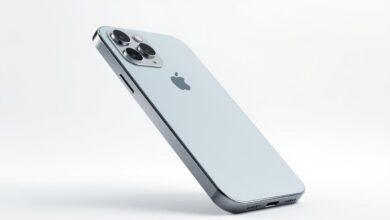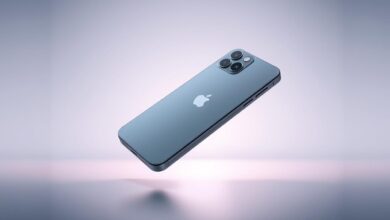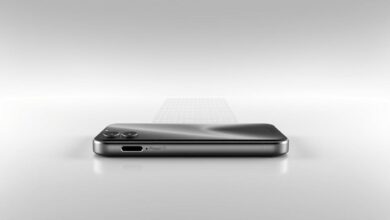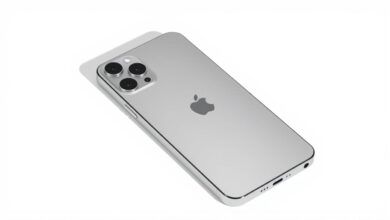How Much Does an iPhone Weigh? Full Weight Chart by Model

Using different iPhone models has shown me how important weight is. It affects how comfortable the phone feels in your hand.
The iPhone weight matters a lot. It decides how easy it is to hold and use for a long time.
Knowing the weight of various iPhone models helps you choose wisely. For example, if you’re thinking about getting a new one, check the weight difference. You can learn more about iPhone weights, like the iPhone 14 Pro Max weighing 240g, on this page.
Key Takeaways
- Different iPhone models have varying weights.
- The weight of an iPhone can impact user experience.
- Knowing the iPhone weight can help you choose the right device.
- iPhone weights have changed over the years with new models.
- The weight of an iPhone is an important consideration for some users.
Overview of iPhone Weights
The weight of an iPhone is key to its usability and satisfaction. Different models weigh differently due to materials, battery size, and design.
Knowing an iPhone’s weight is important. It affects how easy it is to carry and use for a long time. A heavier iPhone might have more features or a bigger battery, but it’s harder to carry.
The Importance of Knowing iPhone Weight
For those who value portability, knowing an iPhone’s weight is crucial. A lighter model is better for always being on the move. But, if you want more features or a bigger battery, you might not mind a heavier phone.
To understand better, here’s a comparison of iPhone weights. Check the detailed weight chart by visiting this link.
| iPhone Model | Weight (grams) |
|---|---|
| iPhone 12 | 162 |
| iPhone 12 Pro | 187 |
| iPhone 12 Pro Max | 226 |
How Weight Affects Usability
The weight of an iPhone greatly impacts its usability. A heavier phone is harder to hold for a long time. A lighter one is more comfortable.
In conclusion, the weight of an iPhone is crucial for user experience. By knowing the weight differences in various models, you can choose the best iPhone for you.
Weight of Older iPhone Models
Looking at older iPhone models shows how Apple’s design has changed over time. As technology gets better, so do the designs, leading to weight changes.
The iPhone 6 and 6 Plus were big steps for Apple, introducing larger screens. This change made them heavier than earlier models.
iPhone 6 and 6 Plus
The iPhone 6 weighed 129g, and the iPhone 6 Plus weighed 172g. The bigger battery and screen of the 6 Plus added to its weight.
iPhone 7 and 7 Plus
Apple made design tweaks with the iPhone 7 and 7 Plus, affecting their weights. The iPhone 7 weighed 138g, and the 7 Plus weighed 188g. The 7 Plus’s dual-lens camera added to its weight.
iPhone 8 and 8 Plus
The iPhone 8 and 8 Plus saw more weight changes. The iPhone 8 weighed 148g, and the 8 Plus weighed 202g. These increases came from bigger batteries and more hardware.
To understand the weight changes, let’s look at a table:
| iPhone Model | Weight (grams) |
|---|---|
| iPhone 6 | 129 |
| iPhone 6 Plus | 172 |
| iPhone 7 | 138 |
| iPhone 7 Plus | 188 |
| iPhone 8 | 148 |
| iPhone 8 Plus | 202 |
This table shows how weights have gone up over time. It reflects the design and functionality changes in these iPhones.
Weight of iPhone X Series
The iPhone X series includes the iPhone X, XR, XS, and XS Max. Each model has a different weight due to various features. These differences come from display size, battery capacity, and materials used.
Weight of iPhone X
The iPhone X is the first in this series. It weighs 174 grams or 6.14 ounces. This sets the baseline for comparing with other models.
Weight of iPhone XR
The iPhone XR has a larger display and different materials than the iPhone X. It weighs 194 grams or 6.84 ounces. This is heavier than the iPhone X, mainly because of its bigger battery and design.
Weight of iPhone XS and XS Max
The iPhone XS and XS Max also have different weights. The iPhone XS weighs 177 grams or 6.24 ounces. The XS Max is heavier at 208 grams or 7.34 ounces. This is because of its larger display and battery.
To better understand the weight differences among these models, let’s examine a comparative table:
| Model | Weight in Grams | Weight in Ounces |
|---|---|---|
| iPhone X | 174 | 6.14 |
| iPhone XR | 194 | 6.84 |
| iPhone XS | 177 | 6.24 |
| iPhone XS Max | 208 | 7.34 |
As tech analysts note, a device’s weight greatly affects its use.
“The weight of a smartphone is a critical factor in its overall usability and comfort during extended use.”
This is especially true when comparing the iPhone XS and XS Max. The larger model’s extra weight is a trade-off for its bigger features and display.
In conclusion, the iPhone X series offers a range of weights for different user needs. Whether you prefer the compact iPhone X or the feature-rich XS Max, knowing their weights helps in making a smart choice.
Weight of iPhone 11 Series
Understanding the weight of the iPhone 11 series is key. It includes the standard iPhone 11, iPhone 11 Pro, and iPhone 11 Pro Max. Each model has unique features that impact its weight.
iPhone 11 Weight
The iPhone 11 weighs 194 grams. It’s lighter than the Pro models. This is because of its aluminum frame and glass back.
iPhone 11 Pro and Pro Max
The iPhone 11 Pro weighs 188 grams. It’s a bit lighter than the standard iPhone 11. This is because of its smaller design. On the other hand, the iPhone 11 Pro Max weighs 226 grams. This is due to its bigger size and battery.
To understand the weight differences, let’s compare the iPhone 11 series models:
| Model | Weight (grams) |
|---|---|
| iPhone 11 | 194 |
| iPhone 11 Pro | 188 |
| iPhone 11 Pro Max | 226 |
Experts say the weight of a device matters a lot.
“The weight of a smartphone is a critical factor in its overall usability and comfort during extended use.”
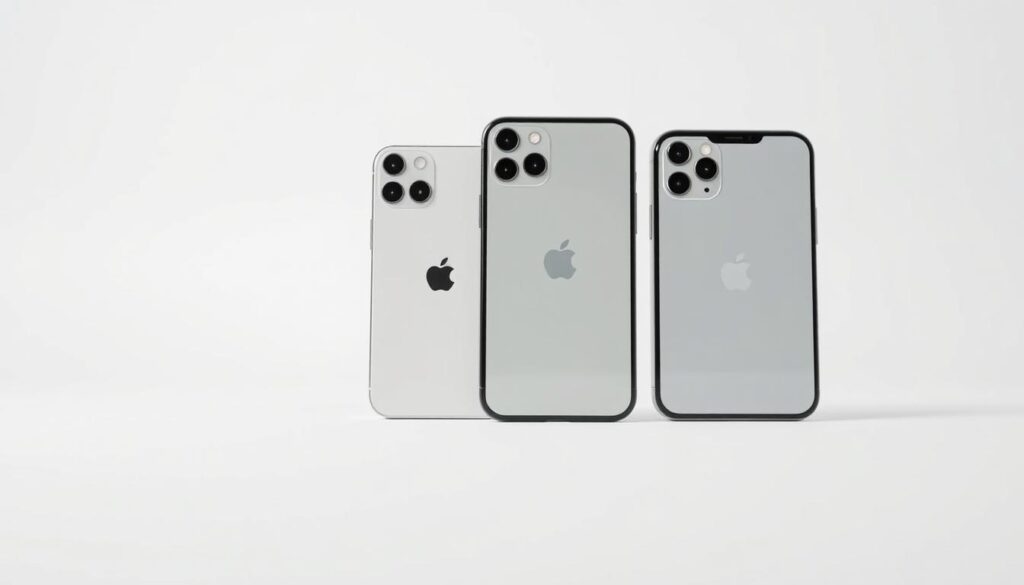
In conclusion, the iPhone 11 series has different weights for various needs. Whether you want something light or a model with a bigger battery, there’s an iPhone 11 series for you.
iPhone 12 Series Weight Comparison
The iPhone 12 series includes the iPhone 12, iPhone 12 Mini, iPhone 12 Pro, and iPhone 12 Pro Max. Each has a different weight due to size and features.
Apple’s innovation led to a variety of choices in the iPhone 12 series. Each model has its own weight, important for those who value portability and design.
iPhone 12 Weight
The iPhone 12 has a 6.1-inch display and weighs 162 grams. It’s a great choice for everyday use.
iPhone 12 Mini
The iPhone 12 Mini has a 5.4-inch display and weighs 133 grams. It’s perfect for those who want a lighter phone.
iPhone 12 Pro and Pro Max
The iPhone 12 Pro has a 6.1-inch screen and weighs 189 grams. The iPhone 12 Pro Max, with a 6.7-inch display, weighs 226 grams. The extra weight in the Pro models comes from better cameras and premium materials.
Tim Cook, Apple’s CEO, said, “Innovation is what drives us to create products that are not just functional but also delightful to use.” The weight differences in the iPhone 12 series show Apple’s focus on both form and function.
Looking at the iPhone 12 series’ weights, it’s clear Apple’s design choices affect the user experience. Whether you prefer a light phone or are okay with a heavier one for more features, there’s an iPhone 12 for you.
Weight Trends Across iPhone Generations
The weight of iPhones has changed over time. This reflects updates in design and technology. These changes show Apple’s focus on innovation and design.
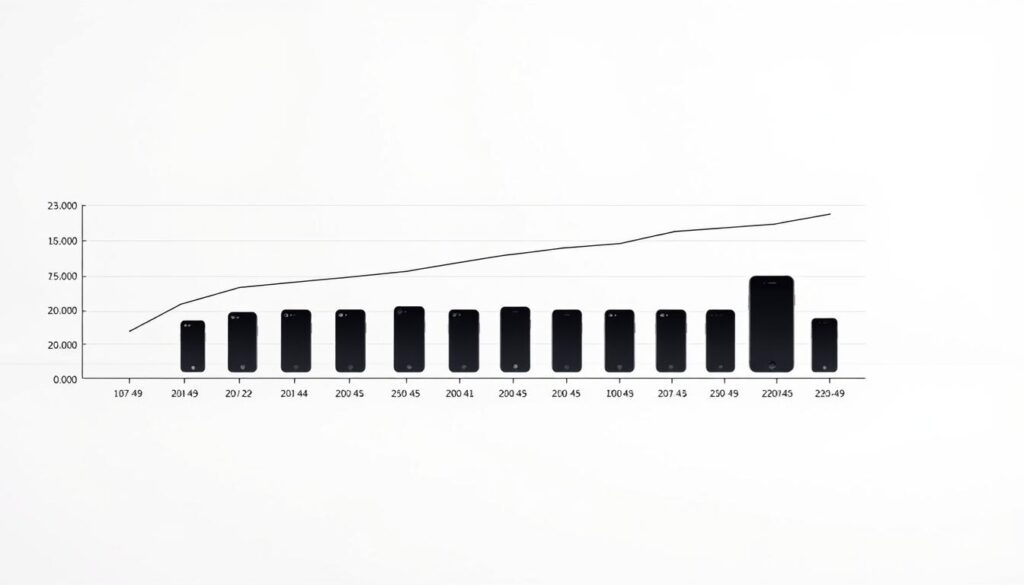
Evolution of iPhone Weight Over Time
The weight of iPhones has gone up slowly. This is mainly because of bigger screens and more features. For example, the iPhone 6 weighed 129g. The iPhone 12 Pro now weighs about 182g.
Newer models sometimes get lighter. The iPhone 12 mini is a good example. It’s smaller and lighter, perfect for those who like smaller phones.
Factors Contributing to Weight Changes
Several things affect how much an iPhone weighs. These include:
- Material changes: Apple has tried different materials like aluminum and stainless steel. These change the weight.
- Technological advancements: Better cameras, bigger batteries, and faster processors also add weight.
- Design modifications: Bigger screens, new features like water resistance, and design tweaks all impact the weight.
These factors make each new iPhone different from the last. They show Apple’s commitment to innovation and design.
What Materials Affect Weight?
The weight of an iPhone is greatly influenced by the materials used. Apple has used different materials in various iPhone models. This affects their overall weight.
Looking at different iPhone models shows that material choice is key. For example, aluminum, stainless steel, glass, and plastic have been used in different ways.
Aluminum vs. Stainless Steel
Aluminum and stainless steel are common metals in iPhones. Aluminum is lighter and used in many models. Stainless steel, on the other hand, is stronger but heavier. The iPhone X series, for instance, has a stainless steel frame, making it slightly heavier than aluminum-framed models.
Comparing iPhones with different frames shows clear weight differences. The table below shows how aluminum and stainless steel frames affect weight in different models.
| iPhone Model | Frame Material | Weight (grams) |
|---|---|---|
| iPhone 8 | Aluminum | 148 |
| iPhone X | Stainless Steel | 174 |
| iPhone 11 | Aluminum | 194 |
| iPhone 12 Pro | Stainless Steel | 182 |
Glass Back vs. Plastic
The back material of an iPhone also impacts its weight. iPhones with a glass back, like the iPhone X and later, are heavier. This is because glass offers a premium feel and supports wireless charging but adds weight.
For more detailed information on iPhone weights, visit this page. It offers a detailed look at iPhone weights across various models.
Impact of Weight on Battery Life
Understanding how an iPhone’s weight affects its battery life is key. The weight comes from the battery size, materials, and extra features. Apple’s design choices are influenced by these factors.
A heavier iPhone usually means a bigger battery. This leads to longer battery life. More massive devices have room for larger batteries.
Heavier Devices and Battery Capacity
There’s a clear link between an iPhone’s weight and its battery size. Heavier models, like the iPhone Pro Max, have bigger batteries. This improves their battery life. For example, the iPhone 12 Pro Max is heavier than the iPhone 12 because of its larger battery.
| iPhone Model | Weight (grams) | Battery Capacity (mAh) |
|---|---|---|
| iPhone 12 | 162 | 2815 |
| iPhone 12 Pro Max | 226 | 3687 |
| iPhone 11 | 194 | 3110 |
| iPhone 11 Pro Max | 226 | 3969 |
How Weight Influences Design Choices
The weight of an iPhone shapes Apple’s design choices. Engineers aim for a device that’s both compact and has a big battery. This balance affects the device’s thickness, materials, and features.
For instance, stainless steel frames in Pro models add weight but make the device more durable. Larger batteries also increase weight but improve battery life.
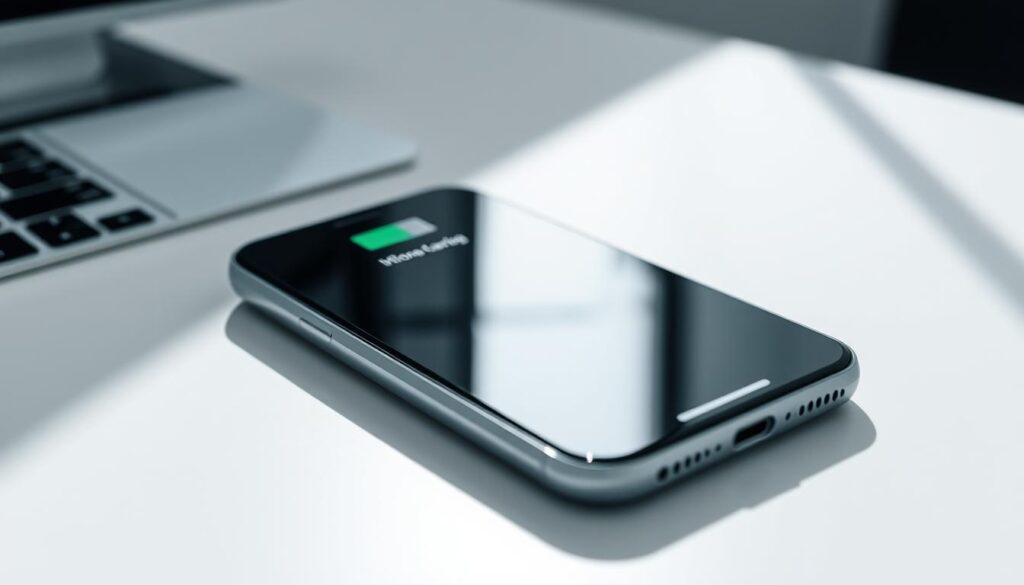
Looking at how iPhone weight and battery life are connected shows Apple’s design is complex. It’s influenced by user needs, durability, and technology.
iPhone Weight and Portability
Knowing the weight of an iPhone is key to seeing if it’s good for daily use. The weight affects how easy it is to carry around. This is important for using it all day.
Carrying Comfort for Daily Use
The weight of an iPhone matters for how easy it is to carry. A lighter iPhone is easier to carry, making it better for daily use. For example, the iPhone 12 Mini, at 133 grams, is made to be light and easy to carry.
But, bigger iPhones like the iPhone 12 Pro Max, at 226 grams, might be harder to carry. They have bigger batteries and more features. This makes them a trade-off between being easy to carry and having more to offer.
Weight Considerations for Accessories
The weight of an iPhone also affects the design of cases and covers. Heavier iPhones need stronger cases to protect them, which can add weight.
When picking accessories, think about the weight. For a light iPhone, a slim case is best to keep it portable. But, a heavier iPhone might need a more protective case, which could make it heavier.
| iPhone Model | Weight in Grams | Weight in Ounces |
|---|---|---|
| iPhone 12 Mini | 133 | 4.7 |
| iPhone 12 | 162 | 5.73 |
| iPhone 12 Pro | 187 | 6.6 |
| iPhone 12 Pro Max | 226 | 8.0 |
In conclusion, the weight of an iPhone is very important for its portability and how it feels to use. By knowing the weight of different iPhones and thinking about accessories, you can choose the best one for you.
Comparing iPhone Weight with Competitors
The weight of a smartphone matters a lot to many users. Looking at how iPhones compare to competitors can give us useful info. People often think about a phone’s features, price, and how it feels in their hand.
We’ll look at the weights of Samsung Galaxy and Google Pixel phones. These are big names in the market.
Samsung Galaxy Weight Comparison
Samsung’s Galaxy series has big screens and lots of features. This can make them a bit heavier than iPhones. For example:
- The Samsung Galaxy S23 Ultra weighs about 233g, making it one of the heavier options in the flagship category.
- In contrast, the iPhone 14 Pro Max weighs approximately 240g, slightly heavier than the Galaxy S23 Ultra.
- The Galaxy S23, on the other hand, weighs about 167g, which is lighter than the iPhone 14 Pro (182g).
This shows that while some Samsung Galaxy models are lighter, others can be as heavy or even heavier than iPhones. It depends on the model.
Google Pixel Weight Analysis
Google Pixel phones are known for being small and light. They are often lighter than many other phones.
- The Google Pixel 7 weighs around 197g, which is relatively close to the iPhone 14 (173g).
- The Pixel 7 Pro, with its larger display and additional features, weighs approximately 212g, still lighter than the iPhone 14 Pro Max.
Google Pixel phones are more compact and lighter than many phones, including some iPhones. They are great for those who want a phone that’s easy to carry.
In conclusion, comparing the weights of iPhones with Samsung Galaxy and Google Pixel phones shows there are many choices. Knowing these differences helps users pick the best phone for them.
The Role of Weight in iPhone Functionality
The weight of an iPhone is key to its durability and how it feels to use. It’s not just about how heavy it is. It shows the device’s design and engineering.
Durability Factors
The weight of an iPhone tells you about its build and materials. For example, iPhones with stainless steel frames are heavier than those with aluminum. This extra weight can make you think the iPhone is premium quality and more durable.
- Heavier iPhones might be more durable because of the strong materials used.
- The weight helps the device resist bending and other stresses.
How Weight Influences User Experience
The weight of an iPhone changes how users interact with it. A heavier iPhone might be better for typing or watching videos. But, it can be harder to carry around.
Things to think about include:
- Comfort: Lighter iPhones are easier to hold for a long time.
- Portability: The weight makes a difference in how easy it is to carry in a pocket or purse.
- Usability: The balance and weight affect how the iPhone feels in your hand.
In the end, the weight of an iPhone balances durability, functionality, and comfort. Knowing this helps users choose the right iPhone for them.
My Personal Preference on iPhone Weight
Over the years, I’ve used many iPhone models. I’ve found that the weight of an iPhone matters a lot. It affects how I use the device every day.
When I think about iPhone weight, I think about how it feels in my hand. A heavier iPhone can be hard to carry, especially for long times. But a lighter one is easier to hold and use for hours.
Daily Use Considerations
The weight of an iPhone changes how I carry and use it. For example, the iPhone 12 Mini is great for activities like running or going to work. It’s light and easy to carry.
To show the weight differences, here’s a table of some iPhone models:
| iPhone Model | Weight (grams) |
|---|---|
| iPhone 12 Mini | 133g |
| iPhone 12 | 162g |
| iPhone 12 Pro Max | 226g |
For more details on iPhone weights, check out this page. It has a full weight chart by model.
Favorite Model Based on Weight
My favorite iPhone is the iPhone 12. It’s light but still has lots of features. The average iPhone weight is around this model’s, making it perfect for everyday use.
In conclusion, the weight of an iPhone is very important. It can really change how you feel about using it. So, choosing a model based on weight is key to finding the right one for you.
FAQs About i
As we’ve looked at different iPhone models and their weights, you might have wondered about some things. Here, I answer some common questions about iPhone weight.
What is the lightest iPhone model? The iPhone 4S and iPhone 5 are among the lightest, weighing 112g each. But, the iPhone 12 Mini is also very light, weighing 133g.
Does a heavier iPhone mean a longer battery life? Not always. Even though some heavier iPhones have bigger batteries, weight also depends on materials used.
How does iPhone weight compare to other smartphones? iPhones usually weigh the same as or a bit more than Android phones. This depends on the model and brand.
Can iPhone weight affect its durability? Yes, an iPhone’s weight can show its build quality and materials. This can impact how durable it is.
FAQ
How much does an iPhone typically weigh?
The weight of an iPhone varies by model. Most iPhones weigh between 140-200 grams.
What is the weight range for different iPhone models?
The iPhone 12 Mini weighs around 113 grams. The iPhone 12 Pro Max weighs over 226 grams.
How does the weight of an iPhone affect its portability?
A lighter iPhone is easier to carry. This makes it more portable.
What materials contribute to the weight of an iPhone?
Materials like aluminum, stainless steel, glass, and plastic affect an iPhone’s weight.
How does the weight of an iPhone compare to other smartphones?
iPhone weights are similar to other high-end smartphones. Samsung and Google models are also similarly weighted.
Does a heavier iPhone necessarily have a longer battery life?
Heavier iPhones might have larger batteries. But, the link between weight and battery life is not always clear.
Can I expect a significant difference in weight between different iPhone models?
Yes, different iPhone models have big weight differences. Some are much heavier or lighter than others.
How has the weight of iPhones changed over time?
iPhone weights have changed over the years. Design, materials, and technology have all played a role.
What is the weight of the latest iPhone models in grams and ounces?
The latest iPhones weigh between 140-220 grams. That’s about 0.3-0.5 pounds.
Are there any iPhone models that are significantly lighter or heavier than others?
Yes, the iPhone 12 Mini is designed to be light. The iPhone 12 Pro Max is larger and heavier.
